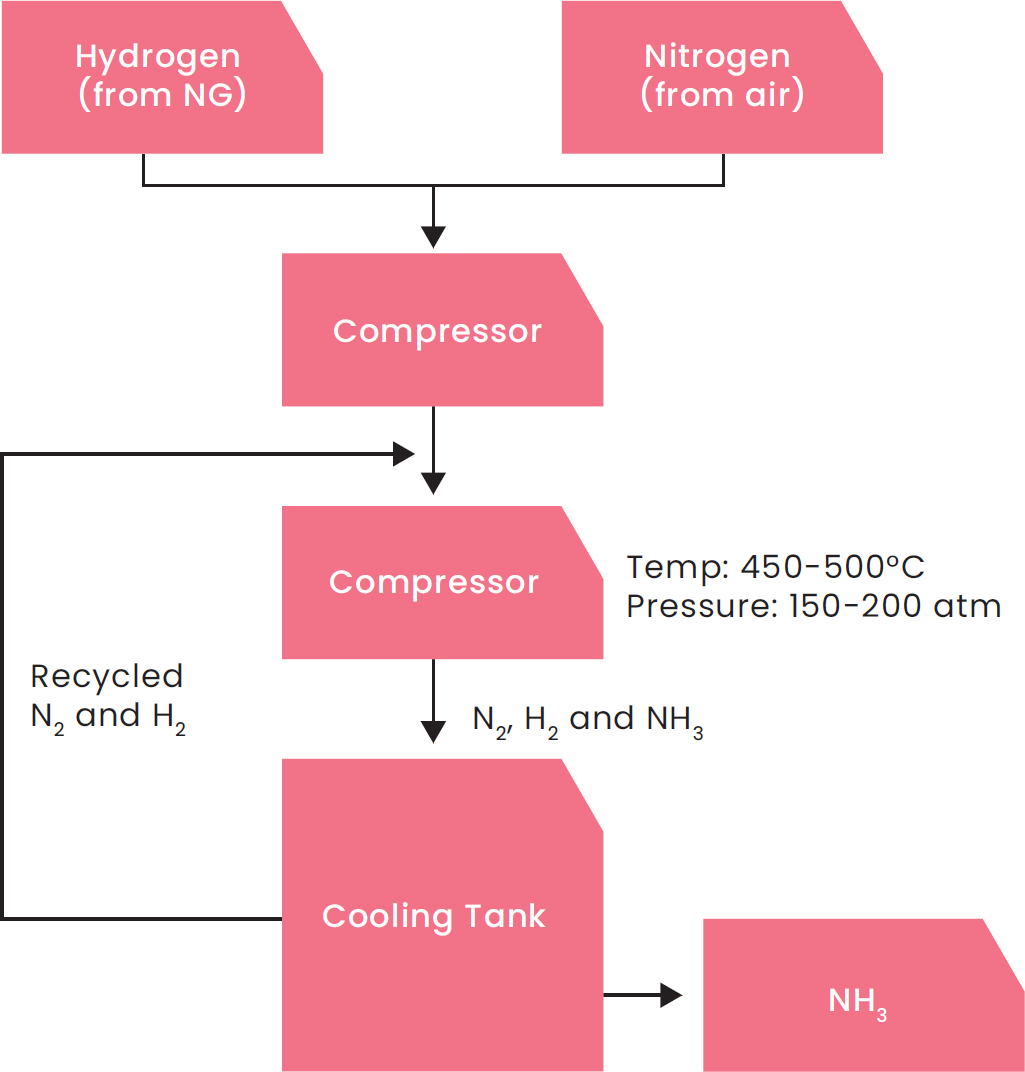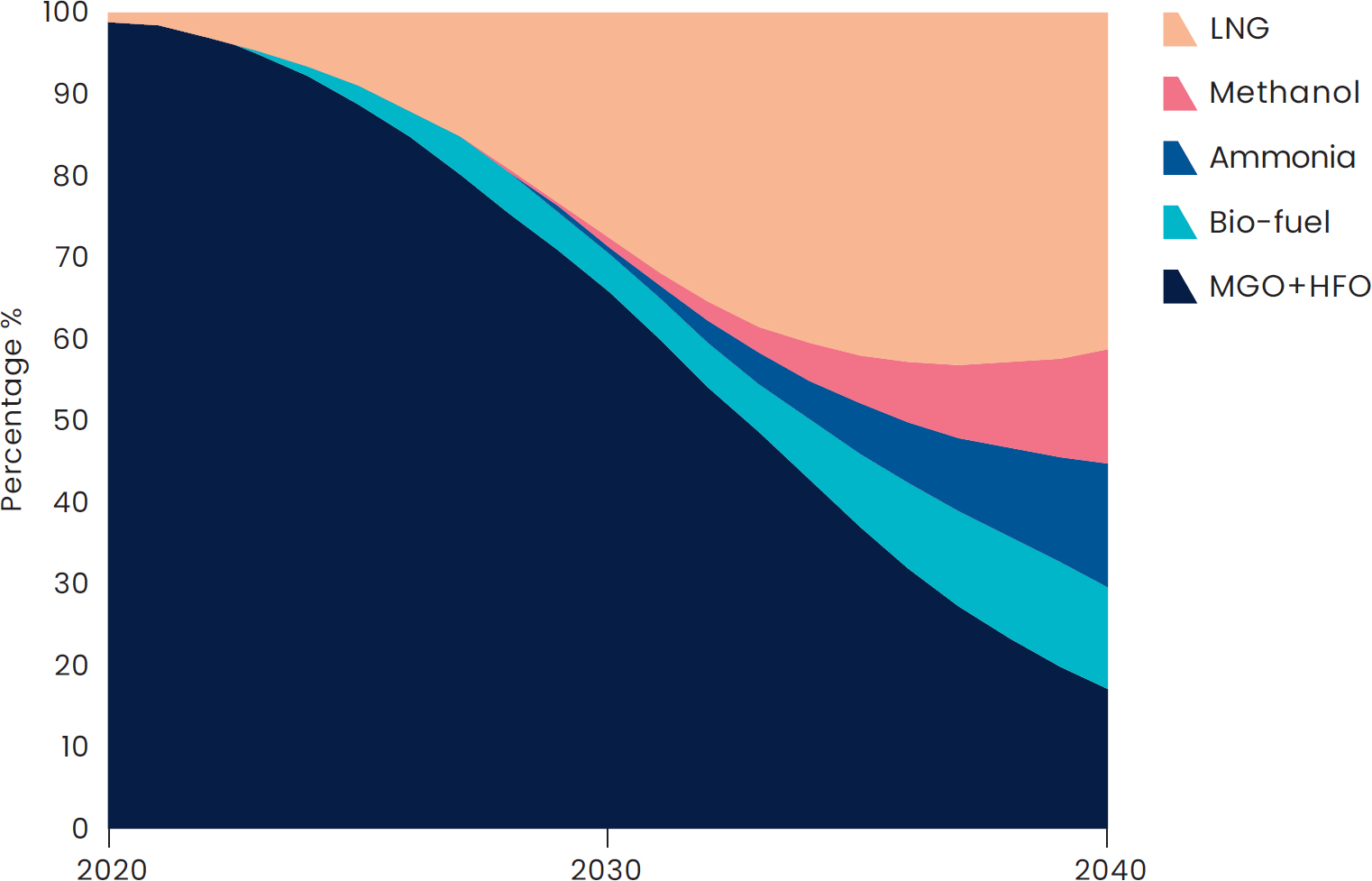11/01/2022
Ammonia fuel for carbon-free shipping?
The maritime industry often ranks high when comparing global greenhouse gas emitters. But when measured by tonnage of transported goods, the benefit of the global shipping industry becomes even more apparent. Energy demands on the maritime sector require a bunker fuel to store energy for long periods of time in order to move the vessel and sustain the people onboard. Alternative fuels are one method to decrease the reliance on fossil fuels and to cut emissions. Low-carbon fuels can motivate growth and bring new opportunities to the maritime industry ranging from shipyards to component manufacturing, bringing a green transition to the business.
The industry’s development is not waiting for new technologies to make a breakthrough on the energy utilization front. Fuel cells, solid-state batteries and small modular nuclear reactors will have a major impact once the technologies have been proven reliable, but in the meantime the transition away
from fossil fuels is already taking place at an accelerating pace and the preparations for future implementation have already started. To fully utilize a vessel over its lifetime, a newbuild ship in the 2020s should be designed to allow a simple transition to adapt to more energy efficient technologies and evolving regulations. The initial step towards the goal here is to concentrate on the energy carrier on board the vessel, beyond natural gas.
In June 2021, I wrote an article discussing the necessary steps towards the utilization of hydrogen as a bunker fuel and the lifecycle emissions of hydrogen production. To recap, hydrogen as an energy carrier for maritime use is the first step towards a carbon-free maritime sector. An economically viable leap towards a hydrogen-economy requires production of hydrogen from purely renewable energy sources and rapid transition from natural gas-based grey hydrogen and carbon capture-proposed blue hydrogen to green hydrogen. Relying on grey and blue hydrogen as the main source of hydrogen will affect the end-goal and can lead to a higher environmental load than the utilization of the initial source-fuel. Hydrogen gas and liquid are especially challenging to store, and alternative ways to store hydrogen are being actively sought.
The pivotal role of green hydrogen in the transition away from fossil fuels is in finding a sustainable way to store and transport it. Discussions today on which fuel will become the dominant energy carrier in the maritime sector varies between different fuels, and subjectively the prime candidates are ammonia and methanol. Both chemicals have well established infrastructure and transportation chains, as well as multiple uses as fuels. But most importantly, both have a relatively simple synthetic production method from hydrogen. We may have to wait for a balance between these two to form over a decade or two, and meanwhile we will have to follow the debate between different camps promoting their own favorites and agendas. For this article I will be investigating ammonia, even though it comes a few years behind methanol regulation and in sense of maturity. But here I am all about reaching zero carbon emissions.
Well-to-Tank
Ammonia fuel is taking a further step toward physical hydrogen storage and toward converting the hydrogen to ammonia, NH3, which in itself contains no carbon. As an energy carrier, ammonia is easier to store and more energy-dense than hydrogen, allowing more possibilities for maritime utilization. The annual production capacity of ammonia is close to 175 million tons, and new many ammonia plants have been planned and announced for the near future. All this ammonia is reserved for agricultural needs and the planned increase will serve the same purpose.
The current production method follows the Haber-Bosch process, which is the origin of the industrial production of ammonia and present fertilizers. Generally, the Haber-Bosch process takes methane from natural gas and nitrogen from the air, and with high temperatures and energy produces synthesis gas, which is further refined to separate hydrogen. The hydrogen and nitrogen produced are used to synthesize ammonia gas. The composition of ammonia, NH3, is one of its major perks as it does not contain any carbon. The result of its simplified combustion reaction is water and dinitrogen, N2. However, incomplete burning might result in N2O emissions, which is a nasty greenhouse gas and the amount needs to be next to nothing for viable ammonia burning process. For possible NOX emissions and NH3 slip, a catalysator unit (SCR) should be considered.
An alternative method to produce ammonia starts from hydrogen and the storage of that hydrogen as ammonia for later use. The method of processing dinitrogen from the air into ammonia electrochemically is already being developed by multiple parties, and with these parties the efficiency of this step seems to be the key to reaching a similar level of viability as the Haber-Bosch process. The key for ammonia replacing fossil fuels as a carbon-free alternative is the realization of hydrogen production through sustainable energy sources. Well-to-wake emissions from ammonia produced by the current method are even higher than burning the initial natural gas.

Tank-to-Wake
The storage of energy as ammonia is not the first step towards sustainable hydrogen production, but from a maritime point of view, the availability of a stable, easily liquefied bunker fuel is welcome. Ammonia is liquefied at favorable conditions of 10 bars at room temperature or at -33°C at atmospheric pressure. In its liquefied form, anhydrous ammonia energy density is still low in comparison to fuel oil, weighting almost 1.5 times more and claiming over 3.5 times the volume, but it is stable and ready to be stored for long periods of time. The most appealing aspect of ammonia as a fuel option is the zero-carbon aspect of the emissions. Zero-carbon emissions for ammonia as fuel in reality is only the simplified version, as there is more to ammonia fuel utilization.
Ammonia burns like wet wood. The poor flammability of ammonia in maritime use leads to the need for a pilot fuel, typically diesel, which unfortunately shatters the image of ammonia as a carbon-free fuel. The pilot fuel will first be the readily available diesel oil, but also bio-diesels, LNG and even hydrogen make good candidates. With low-speed two-stroke engines where ammonia intake is optimized, there will remain a need for a more flammable substance to ignite the fuel. With medium- and high-speed engines the pilot fuel alone is not enough, and a blend with another fuel for improved ignition properties is required. Under certain circumstances this might become beneficial if a more unstable fuel is blended with ammonia, reducing the risk of explosion and fire.
The second challenge on ammonia storage comes from its toxicity. Unlike other low-flashpoint fuels, ammonia gas is not that explosive but is rather toxic, starting from discomfort and irritation to long lasting and life-threatening effects at very low concentrations in air. To prevent contact with the crew, ammonia is classified similarly with low-flashpoint fuel gasses and requires similar caution in storage and handling. Most importantly, what is needed is detectors, ventilation and double walling and isolation on equipment processing ammonia.
Thirdly, as a weak base ammonia is a corrosive substance, leading to the need for special storage equipment. This means the avoidance of copper and nickel and to the need of special stainless steel. Luckily, storing ammonia is possible for half of current C-type tanks on the market. The issue repeats with fuel handling equipment, piping, pumps and seals which will cause limits to the system design. Handled with proper care as liquefied gas, ammonia has potential to be the fuel of the future, ensuring the availability of sustainable ammonia.
Engine manufacturers are carrying out ongoing progress on ammonia engine development and report a market-ready engine for 2024. These engines from manufacturers such as MAN, WinDG and Wärtsilä have invested in bringing a series of ammonia burning dual fuel engines for vessels of various purposes. The system setup between each manufacturer is unique even though the options on fuel supply and exhaust have the same elements. The main issues to solve are pure combustion to prevent N2O and NOX compounds and to optimize the ignition for different engine sets. All parties agree on the upcoming transition in bunker fuels starting from the 2020s.

Summary
Ammonia-ready vessels prepared for conversion are becoming increasingly more common as a basis for new vessels, rapidly capturing the share of LNG-powered vessels. As LNG will still be dominant alternative fuel for newbuilt ships, ammonia is a very interesting environmentally friendly option without the extra emissions from methane slip, to which LNG is prone to. Conversion to an ammonia will require drydocking and replacement on the fuel supply system and engine, and possibly tanks. Room for ammonia tanks is almost double from LNG equivalent, which is a major design aspect that potentially reduces the cargo capacity on a vessel. With innovative design and engineering, there are many options to adjust the fuel tanks inside and outside the vessel so the extra space requirement onboard will be negated and a new generation of ships may surface.
Aside from being used for agriculture, the availability of ammonia for fuel has the same issue as hydrogen: awaiting a green hydrogen supply to make it feasible fuel option. Regardless, the upcoming regulations in the international maritime field on lowering emissions are driving the development of shipping towards less emissions. Even with the current method of providing ammonia being less beneficial in well-to-wake emissions in comparison to natural gas and oil, the engineering today will pave the way for rapid progress towards vessels emitting even less greenhouse gasses. The days of carbon-free shipping are within our reach, and the industry is prepared.
Want to know more?
Marine
We can serve as your partner in the design and construction of ship and offshore wind power solutions with expertise in environmental requirements.
We have extensive experience and an established role as an early adopter of new technologie
Green ammonia from Finland – a synergy of water, wind and land
A derivative of green hydrogen produced from renewable energy, green ammonia has the potential to become a new source of energy and revenue for the Finnish national economy. It allows the country to break its dependence on natural gas imports and provides self-sufficiency to secure agricultural production, power vessels in the future or to be a carrier of green hydrogen. Finland has the ideal mix of resources to produce green ammonia for both its own domestic use and for global distribution.
